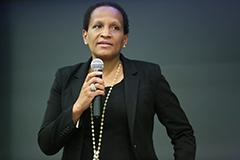Clergy, Womens Advocates, and Scholars Discuss Gender Empowerment
Sanctuary for Families and Columbia Law School's Domestic Violence Project Sponsored a Panel Discussion on Faith-based Perspectives on Gender-based Violence
New York, November 3, 2014—Believe it: Women of faith are fighting the patriarchy from within their holy houses.
Clergy, activists, and scholars convened on Oct. 28 at Columbia Law School to discuss religion's role in allowing and even justifying gender violence. They also described efforts—among Muslim, Christian, Hindu, and Jewish communities—to confront and combat such abuses, including forced marriage, domestic violence, female genital mutilation, and human trafficking.
| Rosemund Pierre-Louis, commissioner of the New York City Mayor's Office to Combat Domestic Violence, introduces the panel. |
The panel discussion, “Faith Perspectives on Gender-Based Violence: Female Genital Mutilation, Forced Marriage, and Human Trafficking,” was sponsored by Columbia Law School's Domestic Violence Project and Sanctuary for Families, which provides advocacy and services to survivors of domestic violence, sex trafficking and related forms of gender violence.
In her opening remarks, Rosemonde Pierre-Louis, commissioner of the New York City Mayor's Office to Combat Domestic Violence and a former staff attorney with Sanctuary for Families, told the audience that the time is right for such a discourse.
“I have never seen so much activity and attention on the issue of domestic violence," she said. "And I think it's so fitting that we're doing a conversation today about faith-based perspectives."
She went on to assert a view that would become a motif in the dialogue: "I can say this as a Catholic: It's important for us to be able to put out there and continue to say boldly, without fear, that there's no religious text or tome that supports the subjugation of women and girls or that supports violence against women and girls."
The talk’s moderator was Sarah Azaransky, assistant professor of social ethics at Union Theological Seminary, who asked panelists to reflect on how religion has been interpreted to justify harm against women and other vulnerable populations.
"Has religion been misused to violate the rights of others? Absolutely," said attorney Engy Abdelkader, co-director of Sanctuary for Families’ Immigration Intervention Project. "In my view, in a Muslim context, I don't think the problem is Islam. I think the problem is the lack of religious literacy."
Abdelkader cited the example of forced marriages.
"Forced marriage is against Islam," she said. "You need a proposal and you need consent. It's a contractual relationship. We're not talking about different interpretations."
| Sarah Azaransky, left, moderates a conversation with (l-r) Reverend Que English, Lauren Hersh, Anindita Chatterjee Bhaumik, Chi Yvonne Leina, and Engy Abdelkader. |
Outsiders' misunderstanding of religious communities can also foster oppression of women, according to another panelist, Anindita Chatterjee Bhaumik, a social worker and community and external affairs coordinator for CONNECT, a nonprofit dedicated to preventing interpersonal violence and promoting gender justice. Chatterjee Bhaumik, who also serves as clergy liaison to the New York City Police Department, said discrimination against Hindus and Sikhs after 9/11 has led to reverse assimilation in those communities—a return to more traditional practices to close ranks and protect the culture.
"We have seen a rise in forced marriages to keep family together within class and race," she said.
Others on the panel described how secrecy and stigmas prevent faith communities from acknowledging gender violence among them.
Reverend Que English, president of the Bronx Clergy Criminal Justice Roundtable and senior pastor at Bronx Christian Fellowship, recounted an instance when a female church leader who came to church with facial bruises after her husband beat her was asked not to participate in the service.
“Another bishop said from the pulpit, ‘If you’re dealing with domestic violence situations in your home, this is really not the place for you to be,’” English said.
Determined to combat such views, English formed the “Not on My Watch” campaign, challenging clergy to act against domestic violence. Her goal is to enlist 200 city houses of worship to serve as safe havens for abuse victims. The effort also raises awareness with bumper stickers and wristbands emblazoned with the “Not on My Watch” motto.
Lauren Hersh encountered similarly secretive attitudes among insular Jewish sects when, as a former Kings County prosecutor, she led one of the nation’s first sex trafficking units.
“I was told, ‘This problem does not affect Jewish people,’” said Hersh, director of Anti-Trafficking Policy and Advocacy for Sanctuary for Families. “Not only were Jewish people victims, they were also perpetrators. When we began to shine a light on this community, we began to make significant progress.”
| Columbia Law School students and community members also join the conversation. |
Chi Yvonne Leina, a journalist from Cameroon and an evangelical Christian, said secrecy allows the practice of breast ironing to persist in her homeland. As girls begin to develop breasts, their mothers use hot stones to burn the tissue in an effort to delay sexual development and activity. Breast ironing can cause cysts, malformation of milk ducts, and even destruction of the breasts, and one in every four girls in Cameroon undergoes the process.
Leina said she uses scripture to persuade women to abandon the mutilating process.
“I go into churches and say, ‘The Bible says women are made in the image of God, and so you cannot destroy the image of God,’” Leina said.


